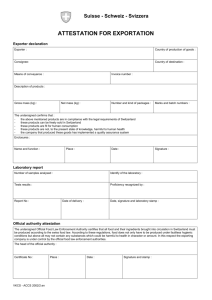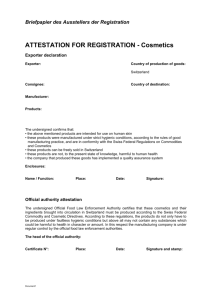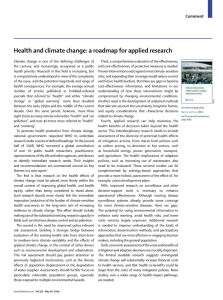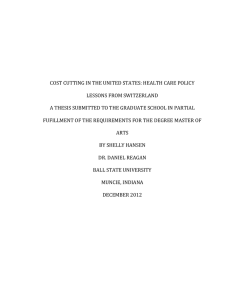Abstract THESIS PROJECT: Cost Cutting in the United States: Health Care... Switzerland
advertisement
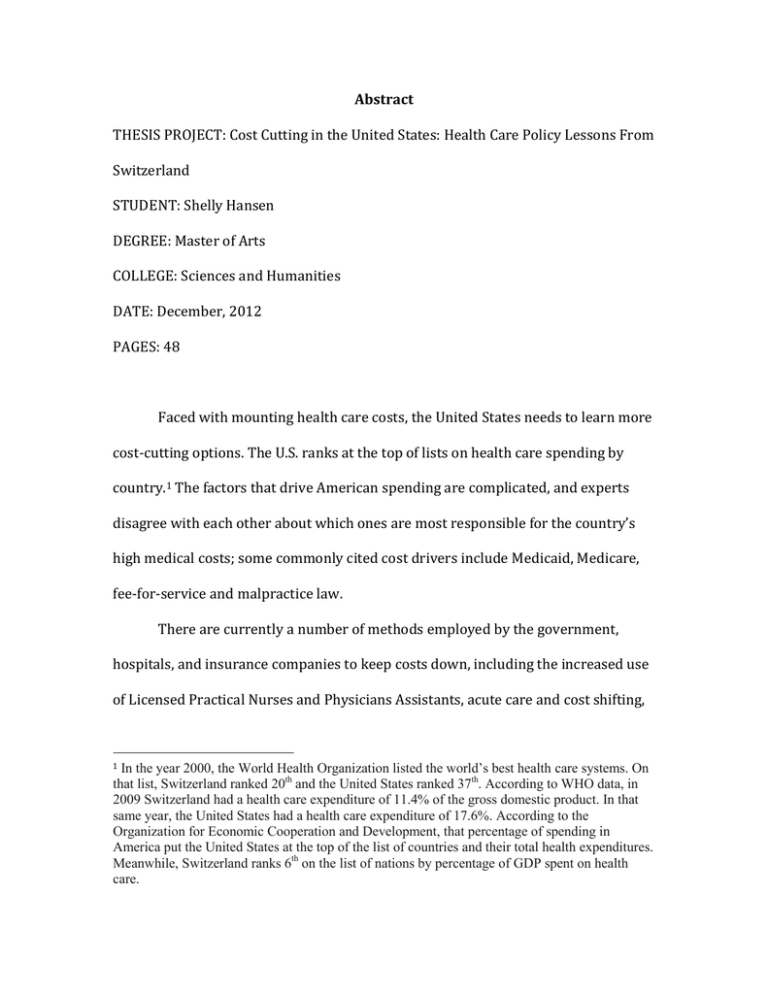
Abstract THESIS PROJECT: Cost Cutting in the United States: Health Care Policy Lessons From Switzerland STUDENT: Shelly Hansen DEGREE: Master of Arts COLLEGE: Sciences and Humanities DATE: December, 2012 PAGES: 48 Faced with mounting health care costs, the United States needs to learn more cost-cutting options. The U.S. ranks at the top of lists on health care spending by country.1 The factors that drive American spending are complicated, and experts disagree with each other about which ones are most responsible for the country’s high medical costs; some commonly cited cost drivers include Medicaid, Medicare, fee-for-service and malpractice law. There are currently a number of methods employed by the government, hospitals, and insurance companies to keep costs down, including the increased use of Licensed Practical Nurses and Physicians Assistants, acute care and cost shifting, In the year 2000, the World Health Organization listed the world’s best health care systems. On that list, Switzerland ranked 20th and the United States ranked 37th. According to WHO data, in 2009 Switzerland had a health care expenditure of 11.4% of the gross domestic product. In that same year, the United States had a health care expenditure of 17.6%. According to the Organization for Economic Cooperation and Development, that percentage of spending in America put the United States at the top of the list of countries and their total health expenditures. Meanwhile, Switzerland ranks 6th on the list of nations by percentage of GDP spent on health care. 1 and Health Maintenance Organizations. In order to learn more about ways to save money on health care, the United States should look to other countries for examples. Switzerland enacted universal health care in 1994; in the nearly twenty years since, the government and insurance companies have instituted measures to control spending. These are practices and policies such as, blue letters of warning for seemingly frivolous doctors, no special insurance program or extra coverage for the elderly, and increased competition. Switzerland spends less on health care each year than the United States and yet has a higher life expectancy. 2 Furthermore, Switzerland celebrates twenty years of universal health care in the same year the individual mandate takes effect in the United States, 2014. Now is a timely moment to see if studying Switzerland’s health care system illuminates the options to American policymakers. Drawing information from scholarly articles, web articles, and website data, I will begin with a literature review section that underscores why a comparison between the Swiss and American health care systems can deepen our understanding of the policy options facing contemporary U.S. policymakers. I will then compare and contrast some specific features of the two health care systems. I will conclude by reflecting on whether and how lessons learned from Switzerland's health care policy can guide the American health care debate. Life expectancy data from the World Health Organization shows Switzerland ranks among the top four countries of the world. In Switzerland, males are expected to live to age 80, while females are expected to live to 84 years. The United States on the other hand does not break into the top 30. It is ranked just above Cuba with males expected to live 76 years and females 81 years. 2


